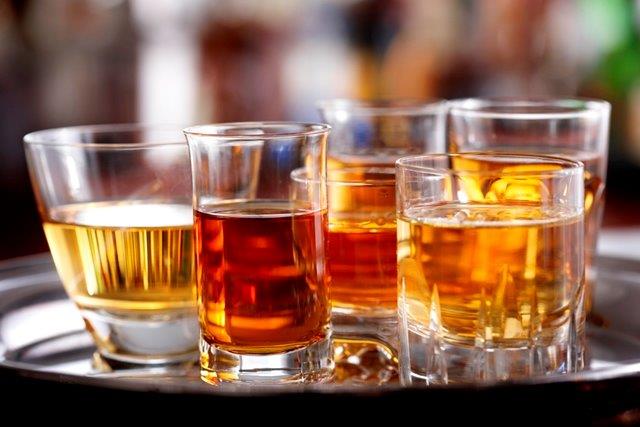EMBARGOED FOR RELEASE | September 09, 2013
The chemistry behind the character of bourbon, scotch and rye
Note to journalists: Please report that this research was presented at a meeting of the American Chemical Society.
A press conference on this topic will be held on Monday, Sept. 9, at 9 a.m. in the ACS Press Center, Room 211, in the Indiana Convention Center. Reporters can attend in person or access live audio and video of the event and ask questions at www.ustream.tv/channel/acslive.
INDIANAPOLIS, Sept. 9, 2013 — Whiskeys have long captivated the senses of connoisseurs, whether with smokiness and a whiff of vanilla or a spicy character with hints of caramel, and now, the emerging chemistry of “brown spirits” is proving that they have distinct chemical signatures to match the complex combinations of grains, barrels, aging and other factors that yield the liquid gold poured into each bottle.
With sales of boutique bourbons and other small-batch whiskeys booming, the chemical fingerprinting of whiskeys was the topic of a talk at the 246th National Meeting & Exposition of the American Chemical Society, the world’s largest scientific society, being held here through Thursday in the Indiana Convention Center and downtown hotels.
Thomas Collins, Ph.D., who presented the research just a few hours from the home of some of the nation’s best-known distilleries, noted that his team’s work profiling 60 American whiskeys has resulted in a treasure trove of information that could prove useful for whiskey-makers large and small as well as for regulators. Comparable work he conducted with wines for his doctoral degree gave winemakers a new perspective on how oak barrels contribute to aroma, he said. He suspects distilleries could likewise benefit.
“Whiskeys’ chemical profiles could be used for distillers’ quality assurance or process improvement programs,” said Collins, research director at the University of California-Davis Food Safety and Measurement Facility. “In addition to that, they could be used to help speed up production. I think many of the small distilleries — the craft distilleries that are cropping up — may be interested in doing that. It’s difficult to get a whiskey business going when you typically need to age the product for three or four years or longer. Another application of our broader project that includes international whiskeys could be helping manage counterfeit and fraud, which is a huge issue for expensive scotches that are exported from Scotland to customers all over the world.”
Using chemistry’s latest analytical tools, Collins’ team found that a single whiskey sample can contain hundreds of nonvolatile compounds, the ones that tend to stay in the liquid rather than evaporate off. Added up across multiple samples, the number of compounds comes to about 4,000 total, a scientific testament to the complex molecular mingling that occurs as a spirit ages, sometimes for decades, in a 53-gallon oak barrel.
The deliberate, tasteful chemistry experiment begins with dense, American white oak wood, usually harvested from forests in the South — though, to the dismay of traditionalists, some newer distilleries are branching out to maple wood and softer French oak used in wine- and cognac-making. Starting with the raw material, whiskey-makers tweak dozens of variables to adjust a spirit’s character. They season the wood for barrels and dry it outside or indoors, a step that exposes it to fungi and bacteria. Factories called cooperages bend the wood into barrels and toast them. The insides of bourbon barrels are charred. Spirits from various combinations of rye, corn, wheat, malted barley and — more recent additions to the whiskey repertoire — oat and millet are added to the barrels. Then additional factors of temperature, humidity and air pressure come into play, affecting how deeply the spirits seep into the wood and interact with its sugars, tannins and other compounds that infuse flavors of vanilla, caramel and others. Lastly, how long a spirit ages plays an important role in its final character.
Of the thousands of compounds in the resulting products, the scientists narrowed the field down to 50 to 100 contributors, including fatty acids, alcohols and tannins, comprising a spirit’s signature that distinguishes a Tennessee whiskey from a bourbon. But not all varieties of whiskey tested were easily identified through chemical profiling, Collins noted. Though the ratios of grains used to make them differ significantly, bourbons and rye whiskeys made in the same distillery developed chemical signatures that looked more like each other than those of bourbons and rye whiskeys, respectively, of another producer. “In some cases, there’s a distillery fingerprint that overrides the difference in the grains,” he said.
Collins’ presentation was part of a two-day symposium called “Polyphenolic Chemistry in Food Science: Flavor, Color, and Biofunctional Properties.” Its nearly 20 talks cover a wide range of topics from the microbes in the human gut to the potential use of diet to manage inflammatory diseases.
To automatically receive news releases from the American Chemical Society, contact newsroom@acs.org.
# # #
The American Chemical Society is a nonprofit organization chartered by the U.S. Congress. With more than 163,000 members, ACS is the world's largest scientific society and a global leader in providing access to chemistry-related research through its multiple databases, peer-reviewed journals and scientific conferences. Its main offices are in Washington, D.C., and Columbus, Ohio.
Media Contact
During the national meeting, Sept. 6-11, the contacts can be reached at 317-262-5907.
Michael Bernstein
m_bernstein@acs.org
202-872-6042
Michael Woods
m_woods@acs.org
202-872-6293






